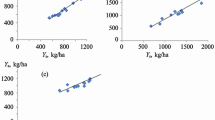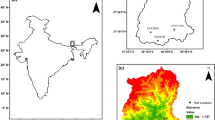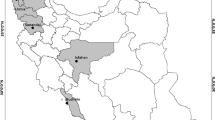Abstract
The FAO CROPWAT tool was utilised to estimate the future reference evapotranspiration and maize crop evapotranspiration for years 2030, 2060 and 2090 under RCP scenarios 2.6 and 8.5 for Sehore district of Madhya Pradesh, India. The statistically downscaled GCM CanESM2 climate model projections were used as input to the CROPWAT for prediction of future reference and crop evapotranspiration data. The values of constants viz. Kcinitial, Kcmid and Kcend were fixed to 0.5, 1.15 and 0.6, respectively, as per the FAO-56 for maize crop. In the Sehore region, the ET0 and ETc values for RCP 2.6 were calculated to be in range of (400.5–512) mm and (430.5–448.4) mm, respectively, during years 2030, 2060 and 2090, while the ET0 and ETc values for RCP 8.5 were found out to be (466–740.5) mm and (440.5–492.5) mm, respectively, during years 2030, 2060 and 2090, respectively. The RCP scenario 8.5 is the worst case scenario in which the reference evapotranspiration as well as crop water requirement for maize crop has been showing high demands of water. The results of this work can be utilised for proper irrigation scheduling for the maize crop and thereby reducing the agricultural risks due to climate change.
Access this chapter
Tax calculation will be finalised at checkout
Purchases are for personal use only
Similar content being viewed by others
References
Agricultural Statistics at a Glance (2017) Directorate of economics and statistics. Department of agriculture and cooperation, Government of India
Johnson FM, Sharma A (2009) Measurement of GCM skill in predicting variables relevant for hydro climatological assessments. J Clim 22:4373–4382
Suppiah R, Hennessy KJ, Whetton PH (2007) Australian climate change projections derived from simulations performed for the IPCC 4th assessment report. Aust Meteorol Mag 56:131–152
Solomon S, Qin D, Manning M et al (eds) (2007) IPCC summary for policymakers. Climate change The physical science basis. Contribution of working group I to the fourth assessment report of the intergovernmental panel on climate change. Cambridge University Press, Cambridge, pp 1–18
Patel HR, Lunagaria MM, Karande BI, Yadav SB, Shah AV, Sood VK, Pandey V (2015) Climate change and its impact on major crops in Gujarat. J Agrometeorol 17(2):190–193
Doorenbos J, Pruitt WO (1975) Guidelines for predicting crop water requirements, Irrigation and Drainage Paper 2. FAO of the United Nations, Rome, p 179
Balvanshi A, Tiwari HL (2018) Analysis of GCMs for prediction of precipitation for Hoshangabad region of Madhya Pradesh. J Agrometeorol 20(4):302–304
Balvanshi A, Tiwari HL (2019) Scenario of climate change and its impacts. Int J Recent Technol Eng 8(1):2601–2604
Rowshon MK, Amin MSM, Mojid M, Yaji M (2013) Estimated evapotranspiration of rice based on pan evaporation as a surrogate to lysimeter measurement. Paddy Water Environ 13(4):356–364
Mehta R, Pandey V (2015) Reference evapotranspiration (ET0) and crop water requirement (ETc) of wheat and maize in Gujarat. J Agrometeorol 17(1):107–113
Pandram V, Choudhary MK (2015) Crop water requirement estimation by using CROPWAT model: a case study of Halali Dam Command Area, Vidisha District, Madhya Pradesh, India. Int J Eng Manage Res 5(3):553–557
Allen RG, Pereira LS, Raes D, Smith M (1998) Crop evapotranspiration: guidelines for computing crop water requirements. Irrigation and Drainage Paper 56 Food and Agriculture Organization of the United Nations, Rome
Author information
Authors and Affiliations
Corresponding author
Editor information
Editors and Affiliations
Additional information
Disclaimer: The presentation of material and details in maps used in this chapter does not imply the expression of any opinion whatsoever on the part of the Publisher or Author concerning the legal status of any country, area or territory or of its authorities, or concerning the delimitation of its borders. The depiction and use of boundaries, geographic names and related data shown on maps and included in lists, tables, documents, and databases in this chapter are not warranted to be error free nor do they necessarily imply official endorsement or acceptance by the Publisher or Author.
Rights and permissions
Copyright information
© 2023 The Author(s), under exclusive license to Springer Nature Singapore Pte Ltd.
About this paper
Cite this paper
Balvanshi, A., Tiwari, H.L. (2023). Climate Change Impact on Future Reference Evapotranspiration and Crop Evapotranspiration for Maize in Sehore District of Madhya Pradesh. In: Timbadiya, P.V., Singh, V.P., Sharma, P.J. (eds) Climate Change Impact on Water Resources. HYDRO 2021. Lecture Notes in Civil Engineering, vol 313. Springer, Singapore. https://doi.org/10.1007/978-981-19-8524-9_30
Download citation
DOI: https://doi.org/10.1007/978-981-19-8524-9_30
Published:
Publisher Name: Springer, Singapore
Print ISBN: 978-981-19-8523-2
Online ISBN: 978-981-19-8524-9
eBook Packages: EngineeringEngineering (R0)




